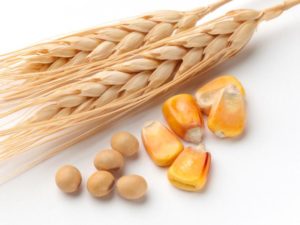 Grain futures were mixed on Friday with wheat and soybeans marking daily gains, while corn declined amid ample supplies and declining demand.
Grain futures were mixed on Friday with wheat and soybeans marking daily gains, while corn declined amid ample supplies and declining demand.
On the Chicago Board of Trade, corn futures for September delivery traded at $5.5725 a bushel at 12:35 GMT, down 0.56% on the day. Prices held in range between $5.6063 and $5.5575. The grain advanced throughout the week, marking an almost 6% weekly advance so far after tumbling 21% during the preceding two.
The U.S. Department of Agriculture said yesterday that U.S. stockpiles, the worlds biggest producer, may stand at 1.959 billion bushels by the end of the 2013-2014 marketing year, up from last months forecast of 1.949 billion bushels. Analysts expected the USDA to cut its projections, but it was increased due to reduced demand outlook from livestock farmers and importers.
Damien Courvalin, a New York-based analyst at Goldman Sachs Group Inc., said in a report: “We continue to expect a significant recovery in U.S. corn and soybean production and lower prices” in the second half, Damien Courvalin, a New York-based analyst at Goldman Sachs Group Inc., said in an e-mailed report.”
In its weekly crop progress report on Monday, the USDA said that corn silking fell behind last year’s pace. As of the week ending July 7, 6% of the corn crop was silked, slightly above the preceding week’s 3%, but well below last year’s 46% and the five-year average 20%.
As for the corn crop condition, the USDA reported it is a lot better than 2012. As of July 7, only 8% of the crop was categorized as “Very poor” and “Poor”, 24% was “Fair” and 68% was of “Good” and “Excellent” qualities. In comparison, during the same week last year, 36% of the crop fell in the “Very poor” and “Poor” categories, 30% in “Fair” and 40% was categorized as “Good” and “Excellent”
Wheat advances
Meanwhile, wheat advanced, marking a 0.43% daily gain by 12:35 GMT. The grain traded at $6.8513 a bushel, ranging between days high and low of $6.8638 and $6.8063 respectively. Futures are headed for a fifth straight day of gains, posting a 3.8% weekly advance so far, the biggest since the five days to May 3.
Wheat was recently supported as low prices lured importers to fill up stockpiles. The USDA cut its projection for global wheat inventories by 4.9% to 172.38 million tons due to rising demand from China. U.S. export sales rose to 1.47 million tons in the week ending July 4, twice more than the previous week, as China purchased 1.02 million tons of wheat.
Japan’s Ministry of Agriculture, Forestry and Fisheries said yesterday the Asian country bought 23,963 metric tons of club wheat grown in Washington state, 1,497 tons of Australian premium-white, 1,710 tons of U.S. soft-red winter and 22,784 tons of western-red-spring wheat from Canada.
Meanwhile, wheat imports from Pakistan, Asia’s third biggest producer, may surge to the highest level in 5 years following a decline in the country’s crop harvest that boosted local prices, making imports more competitive. Abdul Kalim Baakza, senior vice chairman of the Karachi-based Wheat Traders’ Association of Pakistan said for Bloomberg on Wednesday: “We may import up to 500,000 tons of wheat this year.” Traders have already purchased a total 200 000 tons of wheat from the Black Sea Region this year.
Soybeans fairly unchanged
Soybeans swung between gains and losses on Friday, remaining fairly unchanged during the late European session. Soybeans for August delivery traded at $14.7263 a bushel at 12:28 GMT, up 0.03% on the day. Prices varied between days high and low of $14.7775 and $14.7138 respectively. The oilseed has advanced 2.85% for the week so far after settling 0.19% higher the previous one.
According to the USDA, U.S. soybeans inventories may be more than previously estimated above analysts expectations by the end of the year on August 31, 2014, standing at 295 million bushels.
In its weekly crop progress report, the USDA said that as of July 7 95% of the nation’s soybean crop had emerged, up form the preceding week’s 91%, but below last year’s full emergence and the 97% five-year average.
As for the soybeans condition, the government agency reported it was a lot better than last year’s. This year, 7% of the crop was categorized as “Very poor” and “Poor”, 26% was “Fair” and 67% was “Good” and “Excellent”. As of July 7, 2012, 27% of the crop was of “Very poor” and “Poor” quality, 33% was “Fair” and the remaining 40% was of “Good” and “Excellent” quality.





